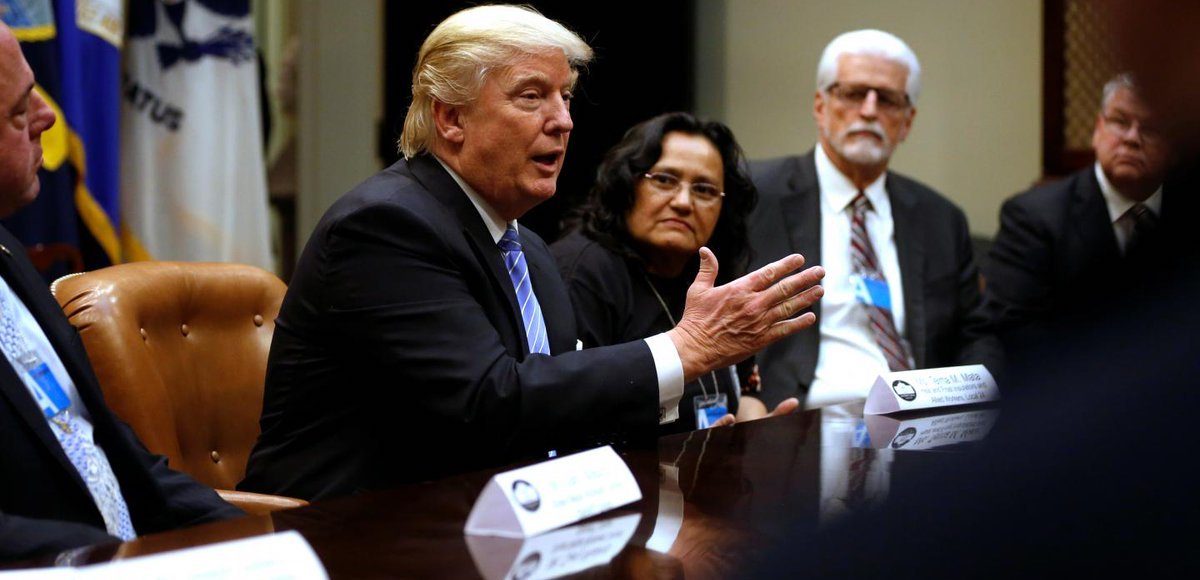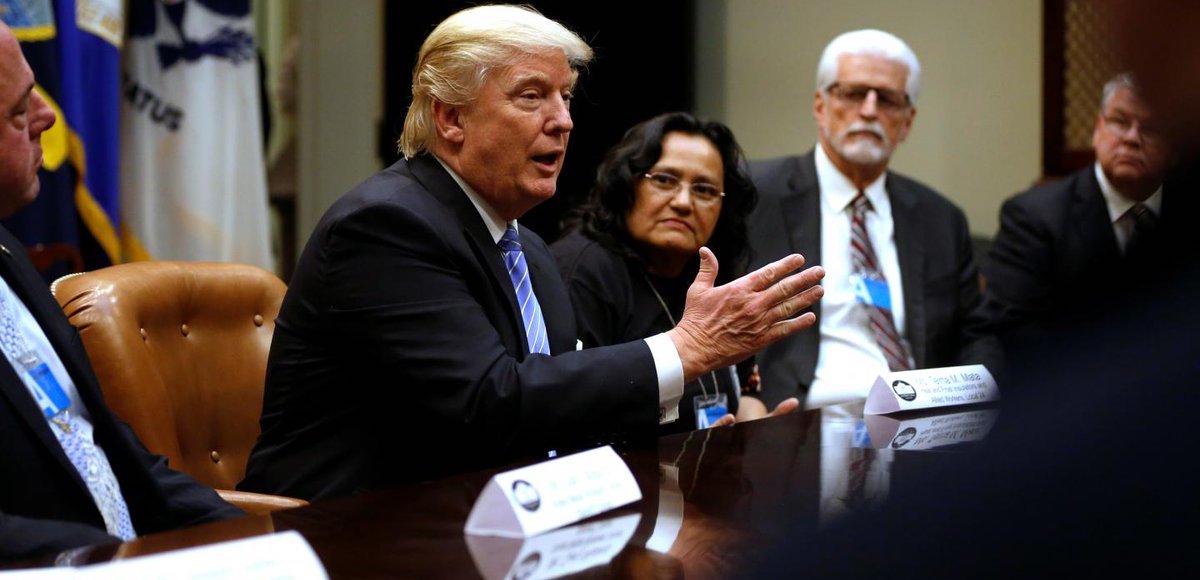

U.S. President Donald J. Trump (C), flanked by Gary Masino (L) of the Sheet Metal Workers Union, Telma Mata (2nd R) of the Heat and Frost Insulators Allied Workers Local 24 and United Brotherhood of Carpenters General President Doug McCarron (R), holds a roundtable meeting at the White House on Jan. 27. 2017. (Photo: Reuters)
When President Trump released his so-called “skinny budget” back in March–dealing with the parts of Leviathan that are annually appropriated–I applauded several of the specific recommendations.
- Shutting down the wasteful National Endowment for the Arts.
- Defunding National Public Radio and the Corporation for Public Broadcasting.
- Terminating the scandal-plagued Community Development Block Grant program.
The only problem is that I didn’t sense – and still don’t see – any serious effort to push through these much-needed fiscal reforms (and the same is true for his proposed tax cut).
The bottom line is that Trump has the power to achieve the bulk of his agenda, but only if he is willing to veto pork-filled bills and force a partial government shutdown. But he’s already blinked once in this type of battle, so the spending lobbies feel confident that he can be rolled again.
But let’s set that aside. The White House is about to release the President’s full budget and there already is considerable angst about potential reforms to Medicaid. Here are some excerpts from a report in the Washington Post.
President Trump’s first major budget proposal on Tuesday will include massive cuts to Medicaid…more than $800 billion over 10 years.
…Trump’s decision to include the Medicaid cuts is significant because it shows he is rejecting calls from a number of Senate Republicans not to reverse the expansion of Medicaid that President Barack Obama achieved as part of the Affordable Care Act. The House has voted to cut the Medicaid funding… The proposed changes will be a central feature of Trump’s first comprehensive budget plan…it will seek changes to entitlements — programs that are essentially on autopilot and don’t need annual authorization from Congress.
I have two reactions to this story.
First, the Washington Post is lying (and not for the first time). There will be no Medicaid cuts in Trump’s budget. Contrary to the headline, there aren’t “big cuts” and there won’t be any “slashing.” We won’t see the actual numbers until tomorrow, but I can state with complete certainty that the Trump Administration is merely going to propose a reduction in how fast the program’s budget increases.
Second, it’s a very good idea to slow down the growth of Medicaid spending.
Here is some background information on the program, starting with an article in The Week by Shikha Dalmia:
Medicaid is arguably the civilized world’s worst health insurance program. …This joint federal and state program has historically allowed the feds to give states 50 cents for every dollar they spent on purchasing health coverage for the poor. Because of this federal largesse, Medicaid has grown astronomically, becoming the single biggest ticket item on virtually every state budget.
…President Obama essentially money-bombed states into expanding it even further. He told states that Uncle Sam would pick up 100 percent of the tab for the first three years for every additional person they covered up to 138 percent of the poverty level. …Medicaid now covers almost 75 million Americans. And even before ObamaCare took effect, Medicaid paid for almost half of all births in America. …The combined annual cost of the program now exceeds half a trillion dollars (with the feds’ share at 63 percent and states’ at 37 percent) — which adds up to roughly $7,000 for every man, woman, and child covered by the program. …Several reputable studies have found that Medicaid patients experience no better health outcomes than uninsured people, and arguably even slightly worse outcomes. …ObamaCare is like a Rube Goldberg contraption. Taking it apart and reassembling it is easier said than done — even if it’s the right and smart thing to do. And if Republicans can’t figure out a way to do so, American patients and taxpayers will be the big losers.
And here are some excerpts from a Wall Street Journal editorial:
The…important goal is to change the incentives over the long term and eliminate the perverse formulas that discount the welfare of the truly needy. …A helpful revolution in Medicaid would be to end the match rate that rewards higher spending and move to block grants. States would get some fixed pot of money annually, determined by how many people are enrolled. The pots might be expensive in the early years, but states would become accountable for marginal per capita spending growth over time. Governors can be assuaged by ending Medicaid’s command-and-control regulatory model, freeing them to use new tools to control costs.
James Capretta of the American Enterprise has additional details, particularly showing how the “federal medical assistance percentage” encourages higher spending.
In 1965, the authors of Medicaid thought they were creating a program that would provide federal structure, uniformity, and some funding for the many state programs that were already providing relatively inexpensive “indigent care” services to low-income households. …Medicaid has grown into the largest health care program in the country by enrollment, with 66 million participants and with annual federal and state costs of more than $550 billion. …Medicaid spending has increased rapidly nearly every year since the program was enacted, creating significant pressure in federal and state budgets. …The Medicaid FMAP is the fundamental flaw in the program’s current design and the main reason it is so costly. States can initiate new spending in Medicaid—spending that often will boost economic activity in the state—and federal taxpayers pay for at least half the cost. At the same time, savings from state-initiated Medicaid-spending cuts are also shared with federal taxpayers. For instance, in a state where the FMAP is 60 percent, the governor and state legislators face the unattractive prospect of keeping only $1.00 of every $2.50 in Medicaid savings they can identify and implement. The other $1.50 goes to the federal treasury. Put another way, governors and state legislators are reluctant to impose $2.50 in budgetary pain for a $1.00 gain to their bottom line.
The solution to this rigged system, he explains, is block grants or per-capita caps.
The…important structural change would be the switch to some form of fixed federal funding to states. The federal government would continue to heavily support the Medicaid program, but the commitment would have a limit, which would give states a strong incentive to manage the program for efficiency and cost control. One approach would be a block grant. Under a block grant, the federal government would make fixed, aggregate payments to the states based on historical spending patterns. Cost overruns at the state level would require the state to find additional resources within the state budget. Conversely, states that were able to control costs would enjoy the full benefits of their efforts. …Under per capita caps, the federal government would establish for each state a per-person payment for each of the main eligibility categories in the Medicaid program: the elderly, the blind and disabled, nondisabled adults, and children. The federal government would then make payments to the states based on the number of Medicaid enrollees in each of these categories. The per capita payment would be based on historical spending rates for the various categories of beneficiaries in each state and, again, would be indexed to a predetermined growth rate.
By the way, I previously shared two very depressing charts from Jim’s article.
In a 2012 column for Forbes, Avik Roy explains why reform will produce good results.
People on Medicaid have far worse health outcomes than those with private insurance, and in many cases those with no insurance at all.
…there are…substantial efficiencies that can be gained by giving states broad flexibility in the way they care for the poor. Indeed, this is what made block-granting welfare in 1996 such a spectacular success. …three states—Rhode Island, Indiana, and New York—have taken advantage of more flexibility to save money while delivering better care. …Rhode Island was able to save $100 million, and slow the growth of Medicaid from 8 percent per year to 3 percent, by making a few tweaks to their program that they couldn’t before…under a block-grant system, states can identify ways to save money while improving care, and other states can adopt best practices.
Writing for the Wall Street Journal, Professor Regina Herzlinger and Dr. Richard Boxer elaborate on how a new system would work.
Republicans should combine two ideas popular in their party: block grants and health savings accounts. The former would let states tailor their Medicaid policies to their local communities, while the latter would give enrollees the ability to choose their own insurers and providers.
In essence, Washington could give the states Medicaid block grants, allocated per capita, to provide beneficiaries with high-deductible insurance and health savings accounts. …Health savings accounts, which force medical providers to compete for consumers who pay out of their own pocket, also reduce overall costs. When employers introduce such accounts, health-care costs are reduced by about 5% for each of the next three years, according to a 2015 study from the National Bureau of Economic Research.
Nicholas Eberstadt, in an article for Commentary, points out the Medicaid is an employment killer.
21st-century America has witnessed a dreadful collapse of work. …According to the Census Bureau’s SIPP survey (Survey of Income and Program Participation), as of 2013, over one-fifth (21 percent) of allcivilian men between 25 and 55 years of age were Medicaid beneficiaries. For prime-age people not in the labor force, the share was over half (53 percent). …means-tested benefits cannot support a lavish lifestyle. But they can offer a permanent alternative to paid employment, and for growing numbers of American men, they do. The rise of these programs has coincided with the death of work for larger and larger numbers of American men not yet of retirement age.
And the icing on the cake is that Medicaid finances much of the opioid problem in America.
[The Medicaid card] pays for medicine—whatever pills a doctor deems that the insured patient needs. …For a three-dollar Medicaid co-pay, therefore, addicts got pills priced at thousands of dollars, with the difference paid for by U.S. and state taxpayers. A user could turn around and sell those pills, obtained for that three-dollar co-pay, for as much as ten thousand dollars on the street. …Medicaid inadvertently helped finance America’s immense and increasing appetite for opioids in our new century.
And if we want a cherry on top of the icing, Medicaid also is a cesspool of fraud, as reported by Reason.
Every year, the Government Accountability Office (GAO) releases a report putting a dollar figure on the amount of improper payments in Medicaid.
…it shows that the program…spends a substantial portion of its annual budget…On fraud, on waste, on services not rendered, not medically necessary, or incorrectly billed. Last year, for example, the GAO found that about 9.8 percent of federal Medicaid expenditures, or about $29 billion, was spent improperly. …This year, the total has risen once again. About 10.5 percent, or $36 billion, of federal spending on the program isn’t up to snuff, according to a GAO report released this morning.
On that issue, my “favorite” example of Medicaid fraud was perpetrated by Russian diplomats.
Last but not least, Charlie Katebi discusses Medicaid problems in a column for the Federalist.
Trump advisor Kellyanne Conway said Trump wants to “block-grant Medicaid to the states” to ensure “those who are closest to the people in need will be administering.” …Block grants would cap federal Medicaid funding and let states decide how to use those dollars. It would introduce flexibility and budget discipline to a program that sorely needs both. …Medicaid’s funding formula incentivizes policymakers to expand the program at the expense of core state government functions. …Medicaid’s structure also hurts its beneficiaries. …Washington bars reformers from making meaningful changes without going through a lengthy and restrictive approval process. This forces states to control costs the only way they can: paying doctors less. States have cut Medicaid’s reimbursement so low that many providers simply refuse to treat its beneficiaries. …Block grants promise to break Medicaid’s vicious cycle of rising costs and declining care. Spendthrift politicians would no longer be able to expand Medicaid and expect the federal government to foot the bill. But state-level reformers will enjoy greater authority to streamline and improve the program.
I may as well close with the video I narrated for the Center for Freedom and Prosperity.





